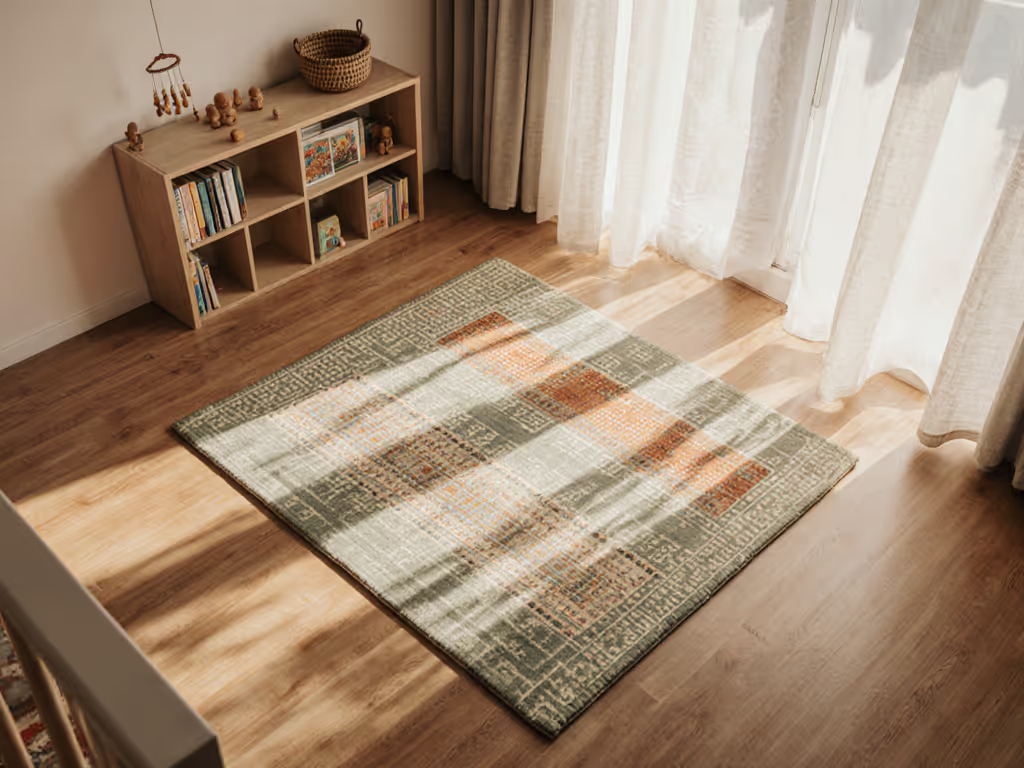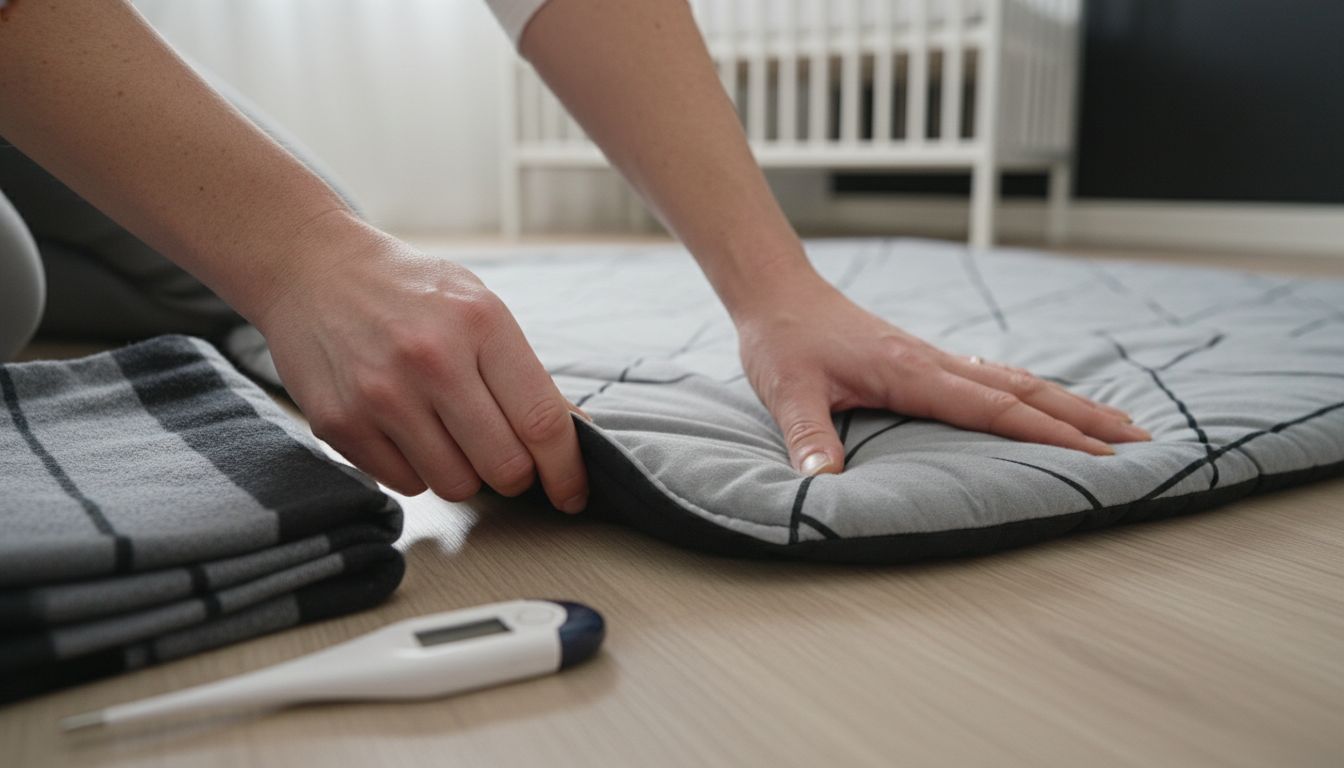
Infant Play Mat Usage Tips for Safe and Engaging Play

Nearly 90 percent of parents worry about keeping their babies safe during playtime. Choosing and setting up an infant play mat goes far beyond picking something cute from the store. Safety, comfort, and the right setup can shape your baby’s first learning adventures at home. This guide offers clear, practical steps so you can create a safe, clean, and engaging play space where your child can explore with confidence every day.
Quick Summary
| Key Point | Explanation |
|---|---|
| 1. Choose a safe location for play mat | Ensure the area has a flat surface away from hazards to promote safe exploration. |
| 2. Set up a comfortable play mat | Unroll the mat completely, checking for evenness and padding for your baby's comfort and safety. |
| 3. Use age-appropriate toys | Introduce engaging toys that encourage movement and cognitive growth, rotating them to maintain interest. |
| 4. Actively supervise playtime | Stay nearby to support exploration while allowing independence, fostering both safety and learning opportunities. |
| 5. Maintain cleanliness of the mat | Regularly clean and inspect the mat for wear to ensure a hygienic play space for your infant. |
Step 1: Choose a Safe and Suitable Location
Selecting the perfect location for your infant play mat involves more than just finding an empty floor space. You want an area that provides safety comfort and developmental opportunities for your little one.
Start by scanning your living space for a zone that offers a flat stable surface away from potential hazards. Hardwood tile or low pile carpet work great but avoid uneven surfaces or areas near stairs sharp furniture edges or electrical outlets. Aim for a spot with good lighting natural temperature control and enough room for your baby to move freely without bumping into furniture. Consider placing the play mat in a common living area where you can easily supervise while doing other tasks but also ensure the space feels comfortable and secure for your infant.
One pro tip many parents overlook is checking the floor temperature. Babies can get cold quickly so avoid drafty areas near windows or air conditioning vents. A small area rug underneath the play mat can provide extra warmth and cushioning. Your goal is creating a safe mini world where your baby can explore learn and grow with confidence.
Step 2: Set Up the Play Mat for Comfort and Safety
Preparing the perfect play mat setup is about creating a safe nurturing environment where your baby can explore and develop motor skills without unnecessary risks. Getting this right means balancing comfort protection and developmental opportunity.
Carefully unroll your play mat ensuring it lies completely flat with no wrinkles or bunched edges that could cause tripping. According to research from activeplaythings experts a play mat should be large enough to accommodate your baby's movements preventing potential falls while encouraging natural exploration. Check the mat surface for any rough spots or potential snags test its cushioning by pressing gently and verify that it provides adequate padding for your infant's delicate body. Pay special attention to the edges making sure they are smooth and securely connected without any loose threads or potential catching points.
A critical safety tip many parents forget is performing a quick temperature check. Babies regulate body heat differently so ensure the mat surface feels comfortable neither too cold nor too warm. If possible place a thin breathable blanket underneath for additional cushioning and warmth. Your goal is creating a safe landing zone that feels like a mini adventure playground for your little explorer where learning and play happen naturally and securely.

Step 3: Introduce Age-Appropriate Toys and Activities
Engaging your infant with the right toys and activities is like unlocking a world of developmental potential. Your play mat becomes more than just a surface its a learning playground that sparks curiosity and supports crucial growth milestones.
According to research from activematters experts strategic playtime activities are essential for physical literacy and cognitive development. Start by introducing simple objects that encourage tracking and reaching skills. Soft lightweight toys with contrasting colors work wonderfully for capturing your babys attention. Place these toys just slightly out of direct reach to motivate your infant to stretch extend and eventually attempt movement. Consider soft rattles textured rings or small plush items that are easy to grasp and safely sized. Supervised tummy time on the play mat is another fantastic way to build neck shoulder and core strength introducing gentle challenges that help your baby develop motor skills.
One pro parent tip is rotating toys every few days to maintain engagement and prevent boredom. Babies are naturally curious so introducing novel sensory experiences keeps playtime exciting and supports ongoing learning. Watch your infants reactions closely some toys might spark immediate fascination while others might need gentle encouragement. Remember the goal is not just entertainment but creating meaningful developmental opportunities that feel like pure fun for your little explorer.
Step 4: Supervise and Interact During Playtime
Parental involvement transforms playtime from a simple activity into a powerful bonding and developmental experience. Your active presence creates a safe supportive environment where learning and exploration thrive.
Research from cypsc highlights the critical importance of active parental involvement during infant playtime. Position yourself close to the play mat where you can observe and engage without being intrusive. Talk to your baby using gentle descriptive language narrating their actions and pointing out interesting objects or movements. Make eye contact smile and respond to their gestures to create meaningful interactions. Use soft encouraging sounds when they reach for toys attempt new movements or show curiosity. Your proximity provides both emotional security and physical safety allowing your infant to explore confidently while knowing you are immediately available if needed.
One crucial tip is maintaining a balance between supervision and letting your baby explore independently. Resist the urge to constantly intervene instead watch closely and only step in when necessary. Babies learn through exploration and sometimes small challenges help develop problem solving skills. Pay attention to your infants cues some moments call for gentle guidance while others require simply being a supportive presence. The goal is creating a playful learning environment where your baby feels both protected and empowered to discover the world around them.
Step 5: Maintain Cleanliness and Inspect for Wear
Keeping your infant play mat clean and in top condition is more than just a chore its a crucial part of creating a safe healthy play environment. Regular maintenance ensures your baby has a hygienic space to explore and learn.
According to experts at activeplaythings cleaning your play mat requires a gentle yet thorough approach. Use a soft damp cloth with mild soap to wipe down the entire surface removing dust crumbs and potential bacteria. Pay special attention to areas where your baby frequently touches or drools. From research by spaces4kids its recommended to perform a comprehensive inspection of the play mat regularly checking for any signs of wear especially around corners and edges. Look for small tears loose threads or areas where the material might be thinning. These potential weak spots can become safety hazards if left unchecked.
One pro tip many parents overlook is establishing a consistent cleaning routine. Consider wiping down the play mat after each play session or at minimum once daily. If your play mat is machine washable follow the manufacturers instructions precisely some materials require specific washing temperatures or gentle cycle settings. Your goal is creating a pristine play space that supports your babys health safety and developmental adventures. A clean well maintained play mat not only looks better but provides peace of mind that your little one is playing in a safe nurturing environment.

Create a Safe and Joyful Play Space with the Perfect Infant Play Mat
Every parent wants a play mat that offers a safe, comfortable, and engaging environment for their baby to explore and grow. The challenges of finding a flat, secure surface free of hazards, paired with the need for proper cushioning and warmth, make settling on the right mat a critical decision. You also want toys and activities that promote development while knowing your baby is always protected through close supervision and regular maintenance.
At FloorBloom we understand these concerns deeply. Our collection is designed specifically with your baby’s safety and comfort in mind using rigorous testing and real-home guidance to ensure each play mat fits beautifully into your family’s daily life. Explore our full selection to find durable, easy-to-clean mats that make supervising your infant a breeze and help create a nurturing space tailored to your child’s needs.
Do not wait until playtime feels stressful or uncertain. Visit FloorBloom today and choose the ideal infant play mat that supports safe, joyful discovery every single day.
Frequently Asked Questions
How do I choose a safe location for my infant's play mat?
Selecting a safe location involves finding a flat, stable surface away from hazards like stairs or sharp edges. Look for a spot with good lighting and enough room for your baby to move freely. Aim to place the mat in areas where you can easily supervise while ensuring your infant feels secure.
What should I check before setting up the play mat?
Before setting up the play mat, ensure it lies completely flat without wrinkles or bumps. Test the cushioning and inspect the edges for rough spots that could pose a safety risk. Create a comfortable landing zone by considering floor temperature and adding a thin blanket underneath if needed.
What types of toys should I introduce on the play mat?
Introduce age-appropriate toys like soft rattles and textured rings that encourage tracking and reaching skills. Place them slightly out of your baby's reach to motivate movement. Rotate toys every few days to keep playtime engaging and stimulating for your little one.
How can I effectively supervise my baby during playtime?
Position yourself close to the play mat to observe and engage without interrupting your baby’s exploration. Use descriptive language and respond to your baby's gestures to promote bonding and learning. Maintain a balance between watching closely and allowing your baby to explore independently, stepping in only when necessary.
What is the best way to clean and maintain an infant play mat?
Clean your infant play mat by wiping it down with a soft damp cloth and mild soap to remove germs and food particles. Establish a cleaning routine, such as wiping it down after each play session, and inspect for wear regularly. This ensures your baby's play area remains hygienic and safe for exploration.
How often should I inspect the play mat for safety?
Regularly inspect the play mat for signs of wear, such as tears or loose threads. Aim to perform this inspection at least once a week to identify potential safety hazards. Taking prompt action on any wear can ensure your baby's play environment remains safe and secure.
Related Articles


What Is a Foldable Play Mat? Complete Guide

Role of Play Mats: Complete Guide for Safe Play Spaces

Play Mat Safety Standards Explained: Essential Guide

